
Spring is in the Air…and in the Oven
Mixed Flowers and Mixed Flours
Our plum tree blossoms are gone and it’s leafing out (background of challah pic below). And Daylight Savings Time stole an hour today. So it must be Spring (despite the drizzle outdoors). The baking this weekend followed the dinners. Roast Chicken calls for Challah. Fresh Pasta and Lamb Ragu calls for Sourdough.
The Challah bake was just the usual. No experiments. Maggie Glezer’s recipe is perfect enough. Always reliable and always delicious.

The Sourdough bake involved some tinkering with my “San Francisco Country Sourdough” formula. It had been a couple months since I’d last played with this part-whole-grain pain au levain. I upped the percentage of whole wheat to 11%. I used Central Milling Organic Artisan Baker’s Craft (enriched) white flour. I baked it into a large batard (one kilo) and two mini-baguettes.
I think the evenness of the crust color on the baguettes may be due, in part to the malted barley flour in the Central Milling Organic Artisan Baker’s Craft flour, and in part to the thorough pre-heating of my oven and stone. The darker edge of the grigne on the batard shows I forgot to turn the oven down after the loaf went in until I removed Sylvia’s Magic Towel set-up (d’Oh!).
The crumb texture is very nice, moist and medium airy, just as I like it. It has a good sour flavor. I let the liquid levain ripen for 16 hours and the dough retarded for about 16 hours. My sourdough-lovin’ spouse describes her ideal sourdough simply as “fairly- but not super-sour, moist and chewy inside, crispy outside”. She says this one hit the mark. One baguette gone already.
Here’s the tweaked formula:
San Francisco Country Sourdough (Sourdough Pain de Campagne) version 3-13-11
Yield: Two 750g Loaves; or Three Mini-Baguettes (235g each) and one 800g Loaf; or One 1000g loaf and two 250g baguettes; or…
Ingredients
LIQUID-LEVAIN BUILD
100 grams AP flour
24 grams Whole Wheat flour
12 grams Whole rye flour
170 grams Water, luke warm
28 Mature culture (75% hydration)
FINAL DOUGH (67% hydration, including levain)
640 grams All-Purpose flour (83%)*
85 grams Whole wheat flour (11%)**
45 grams Whole rye flour (6%)
435 grams Water at room temperature (56%)
17 grams Salt (2%)
306 Liquid levain (48%)
* 3-13 used CM Artisan Baker’s Craft (malted)
** 3-13 used CM Organic Hi-protein fine whole wheat
Directions
1. LIQUID LEVAIN: Make the final build 12 to 16 hours before the final mix, and let stand in a covered container at about 70°F
2. MIXING: Add all the ingredients to the mixing bowl, including the levain, but not the salt. Mix just until the ingredients are incorporated into a shaggy mass. Correct the hydration as necessary. Cover the bowl with plastic and let stand for an autolyse phase of 30 to 60 minutes. At the end of the autolyse, sprinkle the salt over the surface of the dough, and finish mixing 5 minutes. The dough should have a medium consistency.
3. BULK FERMENTATION WITH S&F: 3 hours. Stretch and fold the dough in the bowl twice 30-strokes at 45-minute intervals. Place dough ball in lightly oiled bowl, and stretch and fold on lightly floured board at 45 minutes. If the dough has not increased in size by 75% or so, let it go a bit longer.
4. RETARDED BULK FERMENTATION (optional): After second S&F on board, form dough into ball and then place again in lightly oiled bowl. Refrigerate 8-20 hours, depending on sourness desired and scheduling convenience.
5. DIVIDING AND SHAPING: [Note: if bulk retarded, let dough come to room temperature for 30-90 minutes before pre-shaping.] Divide the dough into pieces and pre-shape. Let sit on board for 30-45 minutes, and then shape into boules or batards or baguettes.
6. PROOFING: Approximately 1.5 to 2.5 hours at 72° F. Ready when poke test dictates. Pre-heat oven to 500 with steam apparatus in place.
7. BAKING: Slash loaves. Bake with steam, on stone. Turn oven to 460 °F after it hits 500F after loading loaves. Remove steaming apparatus after 12 minutes (10 for baguettes). Bake for 35 to 40 minutes total (for 750g loaves; less for smaller loaves). Rotate loaves for evenness as necessary. When done (205 F internal temp), leave loaves on stone with oven door ajar 10 minutes.
Happy Spring!
Glenn
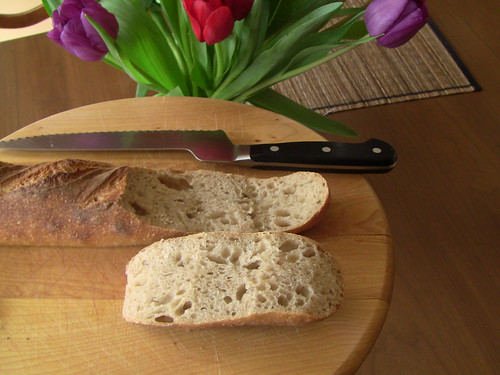
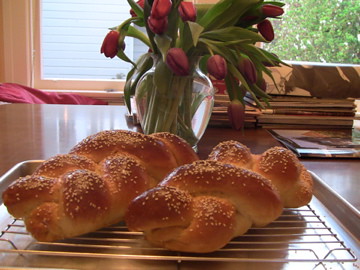
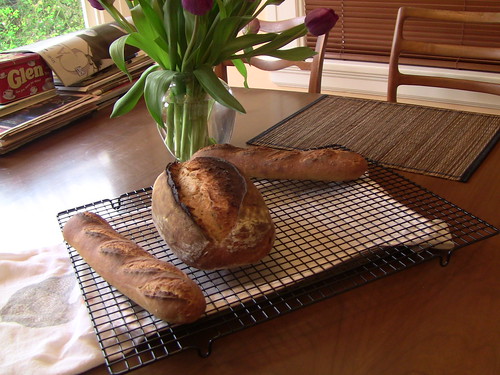
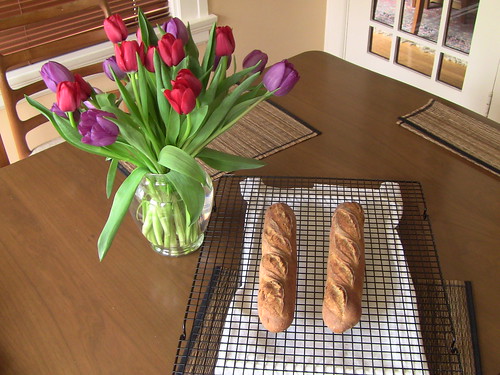
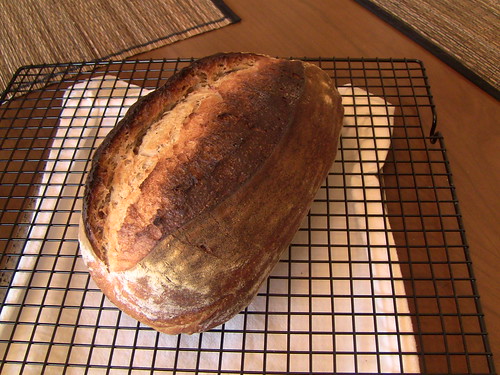
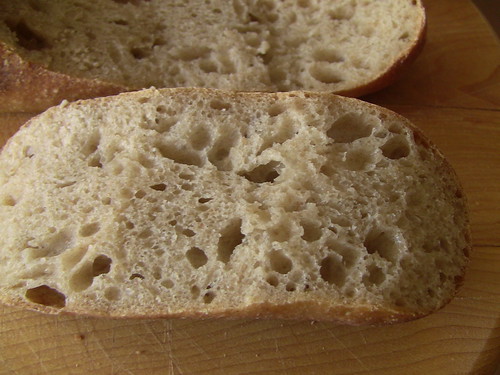


Comments
Very nice Glenn,
We still have snow in the yard but it won't be long now. You certainly have the baguette shaping down. Great looking Spring breads.
Eric
I appreciate the comment. Best wishes for the Spring thaw.
Glenn
Ah Glenn, you have a way with words, always a pleasure to read your posts.
Love the tulips! (well, I would, wouldn't I :) ).
Oh, and: great bakes!!
Thanks, J. I have more years of experience forming good words than forming good loaves. Both are always in need of improvement.
And my spouse does the flower-arranging so much better than I do.
Glenn
Glenn -- thanks for the latest take on your S.F. Country Sourdough. Your directions for the bulk fermentation and S&F don't seem clear to me. Do I understand correctly 2 S&F in the bowl and then a third one on a board? Why the difference? Tnx.
cheers,
jerry
Here's a clearer description: (a) 45 minutes after mixing, S&F in bowl (I do 20-30 depending on resistance); (b) 90 minutes after mixing, S&F in bowl again, and place dough in lightly oiled covered container; (c) 135 minutes after mixing, remove dough to board and do 4-way letter fold (north, south, east, west), (d) 180 minutes after mixing, pre-shape loaves or put dough back in oiled bowl to retard.
Why? It's all about getting the "right" amount of gluten development. During the second half of the bulk ferment, the dough doesn't need as much active stretching to develop strength. You want to stretch it a little, and you want to move the dough around some to even out access to oxygen, but you don't want to overwork it.
Hope that helps.
Glenn
... is quite impossible owing to my dough having developed a lot of resistance very early on. Consequently it soon becomes quite a tight ball. I wonder if this is owing to my having done the finishing 5 minute mixing in my mixer at speed 2? Though it had what I believe was a medium consistency, perhaps it needed a it more water, as the adding of salt seems to have exacerbated the resistance.
Any advice will be appreciated.
The purpose of the S&F's is to develop dough strength. If your dough is showing so much resistance after fewer S&F's that continuing tears the dough, just quit doing them. There is nothing magic about the number of S&F's.
In fact, if you are mixing the dough mechanically for 5 minutes, you may need much less S&Fing to develop the gluten optimally.
Salt does tighten the gluten, as you have observed. It also competes with the flour for water, which interferes with further gluten formation (distinct process from gluten "development"). That's one reason you don't add salt until after an autolyse.
Happy baking!
David
In other words, counting S&Fs is like counting sheep...you should stop when you fall asleep....or something.
I have by now forgotten most of the bread science I never knew. But Brother David always has my back.
Always puts a grigne on my face.
Happy bakers make happy breads.
Glenn
... a great help, and I may borrow your "pun" on occasion, Glenn :-).
I reviewed our brief exchange and did manual instead of mechanical kneading for the autolyse/mixing. Adding to this, I used EVOO as a lubricant on the side of my mixing bowl, work surface and hands.
I was amazed how supple the dough was throughout the process - I could almost sense it relaxing before returning to S&Fs (well into the 20s!) as it firmed up more and more until shaping and onto baking.
So the dough was a pleasure to handle and I now wonder if EVOO is not a semi-essential to get close and "feel" dough as it proceeds along its developmental/formation path. EVOO may not suit all breads, but that is perhaps a minor irritation! The end product suggested it does not detract from SFSD ;-)
Joe
Stretching and folding in the bowl or on the bench have the same purposes: To develop the gluten. To organize the gluten. To even out the dough temperature and redistribute generated components such as CO2, acid, etc. Exposure to oxygen is evened out, but that's a special case, since fermentation is anaerobic.
The advantage of S&F in the bowl is neatness. However, it needs more repetitions. My rationale for combining S&F in the bowl and on the board is that, by time I do it on the board, towards the end of bulk fermentation, the dough is much less sticky and less messy.
David
Isn't the dough less sticky and less messy because of more gluten development?
My biochemistry education is inadequate. Of course, David is right about oxygen not being the factor. Time for me to get some anaerobic exercise.
Glenn
Great Breads..Glenn! Baguette shaping and scoring is almost perfect..!
Tastes good too.
Glenn
I think the decreased stickiness has to do with more of the water in the dough being tightly bound.
That's the non-geek answer. If you would like to explore the fascinating physical chemistry of stickiness in more detail, let me know.
David